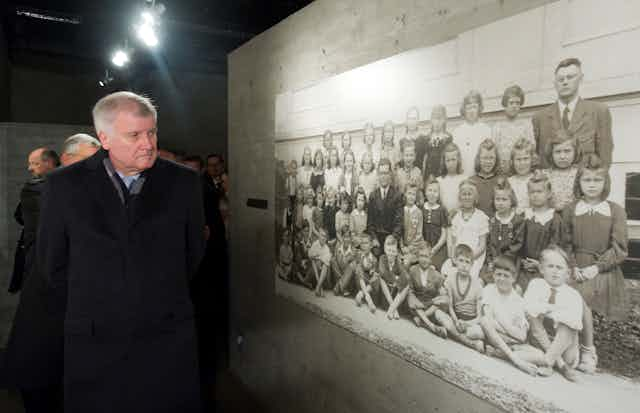The village of Lidice, located a few miles outside the Czechoslovak capital Prague, was the site of a paroxysm of vindictive, pitiless Nazi violence. On the night of June 9 1942, SS guards attempted to completely obliterate the village by killing or deporting its inhabitants, by eliminating every trace of humanity and even by exhuming the dead.
A total of 173 inhabitants were murdered on the spot. The rest were deported to the Nazi-operated extermination camps, where the village death toll rose to approximately 340. Those who survived suffered the fate of forced dispersal.
But an unlikely alliance of Staffordshire miners, a Stoke-on-Trent doctor and a town in Illinois were not prepared to let the memory of Lidice disappear. For decades they fought to put the village back on the map and to help rebuild it.
The fate of Lidice was sealed in the aftermath of the assassination attempt against Reinhard Heydrich, leader of the Nazi-controlled protectorate of Bohemia and Moravia and one of the architects of the Holocaust. The clandestine resistance operation, code-named Anthropoid, took place on May 27 1942. Heydrich was wounded in the attack and died a few days later.
In a token investigation conducted by the Nazi authorities immediately after the attack, Lidice and the village of Ležáky were singled out as symbolic targets of a brutal reprisal action demanded by Hitler. This was despite scant evidence linking them to the Czech resistance and without any proof that inhabitants were involved in the attack.
What followed was total annihilation. The village was surrounded in the late hours of 9 June. By the following afternoon all male inhabitants over the age of 15 had been executed.
Women and children were forcefully removed to a nearby makeshift camp while awaiting deportation. Around 190 women of Lidice were deported to Ravensbruck concentration camp, where about 40 of them died.
Of the estimated 100 children removed from the village only a handful survived, mostly because they were deemed “racially valuable” and therefore suitable for “Germanisation” by being raised by families of SS officials. The rest were deported to a concentration facility in the Polish city of Łódź and then transported to the Chelmno extermination camp in northern Poland, where more than 80 of them were gassed.
The final act in the extermination of Lidice took months to complete. Teams of workers worked methodically to erase every single trace of life in the village. All houses were set on fire and then obliterated with explosives. Animals were killed, roads erased, building foundations dug up, surfaces covered with new soil and plants. Even the dead were exhumed from the cemetery, the tombs and remains destroyed.
A terse Nazi broadcast announcing the retaliatory action against Lidice concluded with the following ominous coda: “The buildings in the village have been razed to the ground and its name erased.”
International response
The Nazi authorities wanted to consign the village to oblivion, where all the threads of individual and community life would be made to disappear without a trace. By setting up an elaborate industry of erasure, they wished their crimes against Lidice to be expunged from history as if the massacre had never happened, as if Lidice itself and its people had never existed.

In this endeavour they did not succeed. News of the brutal Nazi reprisals travelled fast, generating an international outcry and spurring communities into action. The English city of Stoke-on-Trent, led by Polish-born local GP and councillor Sir Barnett Stross, and the North Staffordshire Miners Association started a campaign with the poignant slogan “Lidice shall live”.
The response to Stross’s plea for support from the local community was humbling: in an extraordinary act of solidarity with a fellow mining community the Staffordshire workers donated a share of their wages to help the rebuilding of the village. Their contributions raised an extraordinary fund equivalent to approximately £1 million today.

The campaign for Lidice was officially launched with an event held at Victoria Hall in Hanley, Stoke-on-Trent, in early September 1942. It was addressed by the exiled Czechoslovak president Edvard Beneš and attended by thousands of local supporters.
There was other international support for the preservation of Lidice’s memory. Across the Atlantic, a housing settlement in Illinois originally called Stern Park decided to rename itself Lidice in order to “perpetuate the name” of the destroyed Czech village. Years later Stross launched an open call for the creation of a special collection of artwork donated by international artists in memory of and protest to the Nazi brutal campaign to wipe out Lidice.
Read more: Rise and fall in the Third Reich: Nazi party members and social advancement
Lidice did, and does, live. Following liberation, the restored Czech government decided to rebuild the village 300 metres from where the ravaged settlement once stood. Another campaign by Stross helped locate the surviving children and bring them back to the new Lidice. The initiatives launched by Stross and embraced by the local community forged a special relationship between Stoke-on-Trent and Lidice that thrives today.
On the 80th anniversary of the massacre, we owe it to all of them – to those who perished, to those who returned, and to all those across the world who vowed to keep the name of Lidice alive – to cherish and protect the memory of what unfolded on that night in June in an unassuming mining village, perpetrated by humans against fellow humans.

